How to breed bloodworms correctly at home
A bloodworm is a mosquito larva that is used to feed fish that live in an aquarium or as bait when fishing with a rod. You can grow bloodworms at home. Subject to all the rules and recommendations, this type of activity can bring good profit. Breeding bloodworms at home is a business that can be recouped quickly enough.
Premises and conditions of detention
Those who want to start their own business can arm themselves with a bucket and go to the lake to extract larvae by washing.
If small volumes of production are planned, it is enough to use a small room in the house or a heated barn in your yard for breeding. In order to grow bloodworms from eggs, a novice entrepreneur will have to take care of creating two workshops. The first will contain adults, and the second will contain hatched insects.
To divide the room into a couple of parts, you will need a fine mesh. It is very important that adults cannot reach the hatched larvae. It is imperative to install mosquito nets on window openings in order to prevent extraneous mosquitoes from entering the room.
In workshops that are intended for breeding bloodworms, you should install:
- heating system;
- ventilation;
- conduct water.
In rooms, it is important to keep the temperature at 18-20C. Low temperature conditions slow down the growth of insects. Their body becomes excessively fragile, which makes it impossible for them to tolerate transportation normally. The humidity in the workshop should reach 70%. For normal growth, the bloodworm does not require special conditions with respect to lighting. Insects can thrive in absolute darkness.
When breeding, it is important to observe conditions that are identical to the natural habitat. To do this, you need to take care of the availability:
- rectangular reservoir with elongated outlines;
- the bottom isolated from the soil, which will be located at a slight slope;
- continuous flow;
- water column in a reservoir, reaching 10-12 cm;
- 3-5 m length of an artificial reservoir;
- suitable temperature conditions.
It is important to ensure constant water circulation. However, in this case, the flow should be controlled so that the water does not flow at a high speed, but gradually moves. To ensure such conditions, you will need to purchase a pump capable of pumping water in a circle. People engaged in breeding bloodworms are advised to systematically introduce vitamin mixtures and fertilizing into the reservoir.
Where to get raw materials
Mosquito larvae live on the bottom of the reservoir and in the silt. In order to get the raw material, you will need to wash it with a special device (a bucket with a long handle). The device can be built with your own hands. To do this, you need to make a rim from a steel bar and put a metal mesh on it. The length should be equal to the depth of the reservoir, and the volume should be equal to 7-10 liters.
With the help of a bucket, sludge is scooped up from the bottom surface along with the contents. The sand is gradually washed out, and particles of debris and bloodworms remain in the bowl. It is believed that it is best to catch mosquito larvae in the cold season through an ice hole. In the spring-autumn period, boats are used for washing. In the summer, raw materials cannot be mined.
We breed bloodworms at home
When breeding insect larvae, it is important to adhere to the basic guidelines for growing.
Obtaining mosquito eggs and larvae
The workshop should create suitable conditions for growing larvae. Having installed the container, it is necessary to fill it with water so that the depth does not exceed 3 cm. Females lay eggs in the aquatic environment and die.
It is advisable to give the water a yellowish tint in order to simulate the marsh conditions preferred by insects. After laying, the eggs, located in the container, move along with the container into an artificial reservoir filled with a small amount of water. After 3 days, the larvae appear, which are subject to further sorting. About 12% of the larvae should be placed in the same workshop for further rearing of queens in order to obtain eggs. The rest of the larvae are distributed in another room. It is here that they will be able to fully develop and turn into a full-fledged bloodworm.
Growing bloodworm larvae
The first step is to prepare a container with sides, the height of which reaches 3 cm. After pouring boiling water over the sludge, put it in a container. This environment is ideal for larval development.
To feed the larvae during this period, you should use yeast previously diluted in warm water and mixed with a small percentage of dirt in the pan. Temperature control in the workshop is one of the main conditions for growing larvae. In the case when the temperature was slightly higher or lower than normal, the larvae should be fed every 2-3 days. Under optimal conditions, it is sufficient to feed once every 2 weeks. Excessive amount of yeast in the feed provokes the onset of the decay process. To prepare a meal, the type of yeast alternates. Fresh yeast is used the first time, dry yeast second.
Bloodworms develop quickly enough. The egg develops into a larva in just a couple of weeks. After that, you can deal with the separation of bloodworms from the mud accumulation.
Step-by-step process of separating larvae from dirt:
- After placing the dirt with bloodworms on a sieve, rinse it under water.
- The sludge will begin to sift through the holes, and the bloodworm will remain in place.
- Having separated the larvae, they should be collected in a mesh bag and washed thoroughly under running water.
For the next generation, the sludge can be reused. Having decided to create a production for breeding mosquito larvae, it is important to calculate the number of future insects in order to understand how large the workshop will be needed.
Cultivation of bloodworm queens
Eggs will be required for the next growing cycle insects... It is much easier to raise queens on your own than to catch them on the street using a net. The process of growing mosquitoes is identical to the process of obtaining bloodworms.
It should be borne in mind that the larva stays in the pupal state for only 5 days. Therefore, the part of the bloodworm that does not need to be left for the development of the queens will need to be sold as soon as possible.
After the appearance of the female mosquito, the insects prepare for the appearance of offspring. Feeding during this period can be excluded. Having gained a little mass, insects move on to mating and laying eggs. The female dies after laying. The cycle repeats again.
The process of growing mosquito larvae is divided into a couple of stages:
- the stage of obtaining eggs, from which the larvae will soon hatch;
- the stage of growing mosquito larvae until pupation.
It is very important to control the conditions in which the bloodworm is kept. Drying of sludge in the tank is unacceptable.
Feeding
The larvae must be fed from the moment they appear. On the first day, they feed on masonry mucus, after which additional feed can be introduced. The main food of bloodworms is yeast. For every sq.m. it is recommended to add 100-110 grams of yeast, previously diluted in water. A few days before sampling, the dosage of yeast for feeding is reduced to 45 g. If desired, a small percentage of organically pure chicken droppings can be introduced into the reservoir.
It is best to use organic foods such as:
- feed mixture for fish;
- bread.
Top dressing is thoroughly mixed with silt and spread in a thin layer on the bottom surface. Additional feed is added once every 7-8 days. By settling the tubifex in a homemade reservoir, you can improve the growth of plants.
Mistakes for aspiring entrepreneurs
Very often inexperienced entrepreneurs make mistakes when breeding bloodworms. The most common ones are described below.
- Low temperature. With a decrease in the recommended temperature regime, it is possible to significantly slow down the development of the larvae.
- Excessive water volume in the dilution tank. The oxygen supply to the larvae deteriorates and bloodworms die.
- Use of containers after chemicals. Chemicals persist even after thorough washing. Normal reproduction of bloodworms in such a container is impossible.
Temperature violation
At elevated temperatures, it is important to reduce the amount of yeast for feeding. Failure to comply with this rule leads to the occurrence of a decay process. A mixture of methane and hydrogen sulfide will begin to enter the air. Violation of the temperature regime also slows down the development of larvae. It is extremely important to follow the rules and recommendations regarding the room temperature when breeding insect larvae. This will allow you to grow a quality product and get a good profit.
Features of breeding bloodworms in winter
In the cold season, the most important features of breeding bloodworms are:
- compliance with the temperature regime in the room within 18-20C;
- no drafts in the workshop.
The rest of the growing process is no different from breeding the rest of the year.
Collecting bloodworms
Collecting should be done before starting the pupation process. From the containers, transfer the entire contents to the mesh drum for rinsing. The drum is started with an electric motor, but manual rotation can be used. Sludge comes out during the washing process. The larvae remaining on the surface should be transferred to mesh bags and washed thoroughly under running water. As a rule, per day from 250 sq.m. it is possible to collect 3 kg of bloodworms.
Storage of products
It is impossible to sell the goods instantly, so the entrepreneur must take care in advance of ensuring certain conditions for storage. The main advantage of bloodworms is to keep them alive after freezing. However, the fragility and tenderness of the larvae, if stored improperly, contributes to the death of the mosquito larvae. Dead fish are not used as bait and food.
Bloodworms can withstand low temperatures, but experts recommend storing them at 0 C. There are several methods for storing products:
- Freezer storage and defrosting under water. Moss is laid out on the surface of the bottom of the container. Only then can the larvae be placed.
- Storage in the lower section of the refrigerator.
- Storage in a toilet cistern. The raw material is placed in nylon stockings and immersed in water.
- Storage in large glass containers in which layers of algae and larvae are formed. Containers with wet foam rubber at the bottom are kept in cool rooms with a high level of humidity.
In large-scale production, products are kept in water. The most important thing is that the larvae are completely immersed in the water. The water layer should be within 1.5-2 cm. Each of the larvae should have access to water.
It is unacceptable to store too much bloodworm in a small container. This will result in injury and product caking. Such storage involves a systematic change of water. It is very important to avoid sudden temperature changes.
In the cold season, you can store bloodworms in a container outside.
Profit calculation
To calculate the profit, you need to know the cost of the larvae. The cost item includes not only the food supply, but also the payment for communications.For each kg of production, at least 500 g of yeast is required. You can buy bloodworms for breeding at a wholesale cost of 55-75 rubles. per kg. Growing mosquito larvae in an apartment, the price of a kilogram will be 80 rubles. Depending on the region, the market value will be 350-3000 rubles. per kg. If, in the calculations, the cost of 1000 rubles is used, it can be established that the entrepreneur will earn 920 rubles from each kg.
Seasonality is important when calculating the exact performance. In the cold season, there is an oversupply of production, and in the hot season, a small percentage of larvae die. In case of an oversupply of products, it is necessary to organize the freezing of goods in small layers for the purpose of further sale. Wholesalers buy goods in kilograms, and a retail buyer takes small batches, so you need to think in advance about packing and packaging.
Having decided to start breeding bloodworms at home, at first you will have to adhere to the basic rules and recommendations regarding the growing of insect offspring. In the future, the entrepreneur will understand from his own experience all the subtleties of production and will be able to establish a circular cycle taking into account his own mistakes.
Video about the bloodworm breeding business:



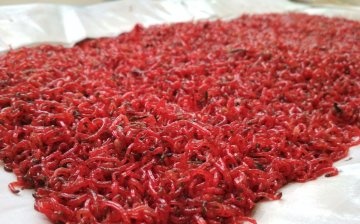
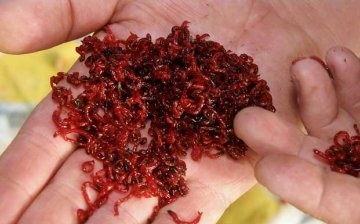
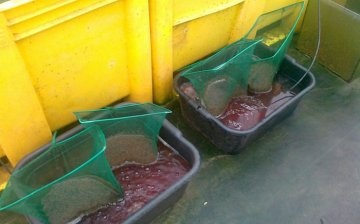



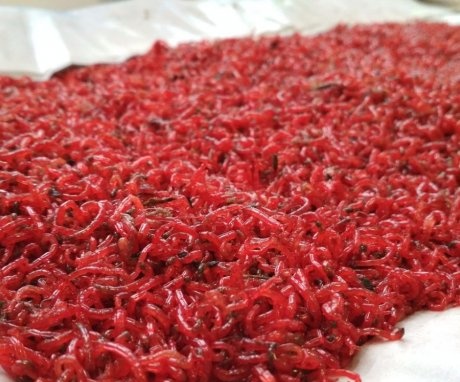
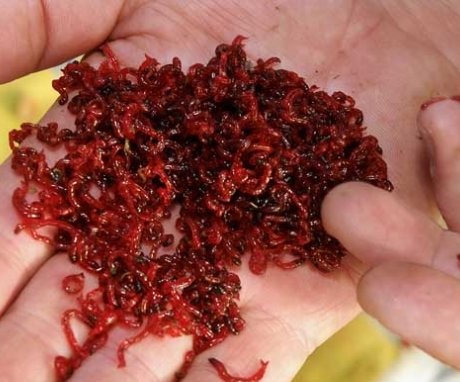
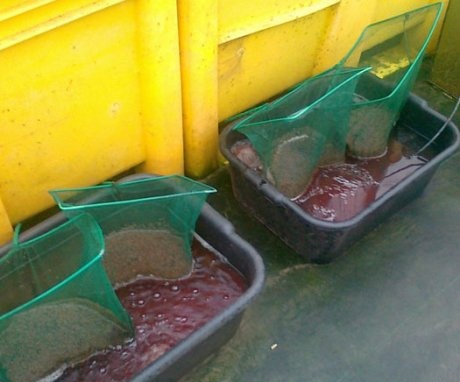
Recently, a dead bloodworm, apparently frozen, was sold to my mother at the market, the price was not thrown off. She brought him home and feeds the fish. As you understand, I am very against this, how can I explain to her that it is impossible to do that?
Despite all the seeming simplicity, growing bloodworms is a rather complex business. The main problem is that it is necessary to sell products quickly, in just five days, otherwise, the bloodworm will move to the next stage of mosquito development.
Bloodworms and tubifex are excellent live food for aquarium fish. Earlier, when I had an aquarium at home, I bought this food on the market. I kept it in the refrigerator, it was enough for almost a week. I didn’t know that it could be bred, our fishermen get it in water bodies.